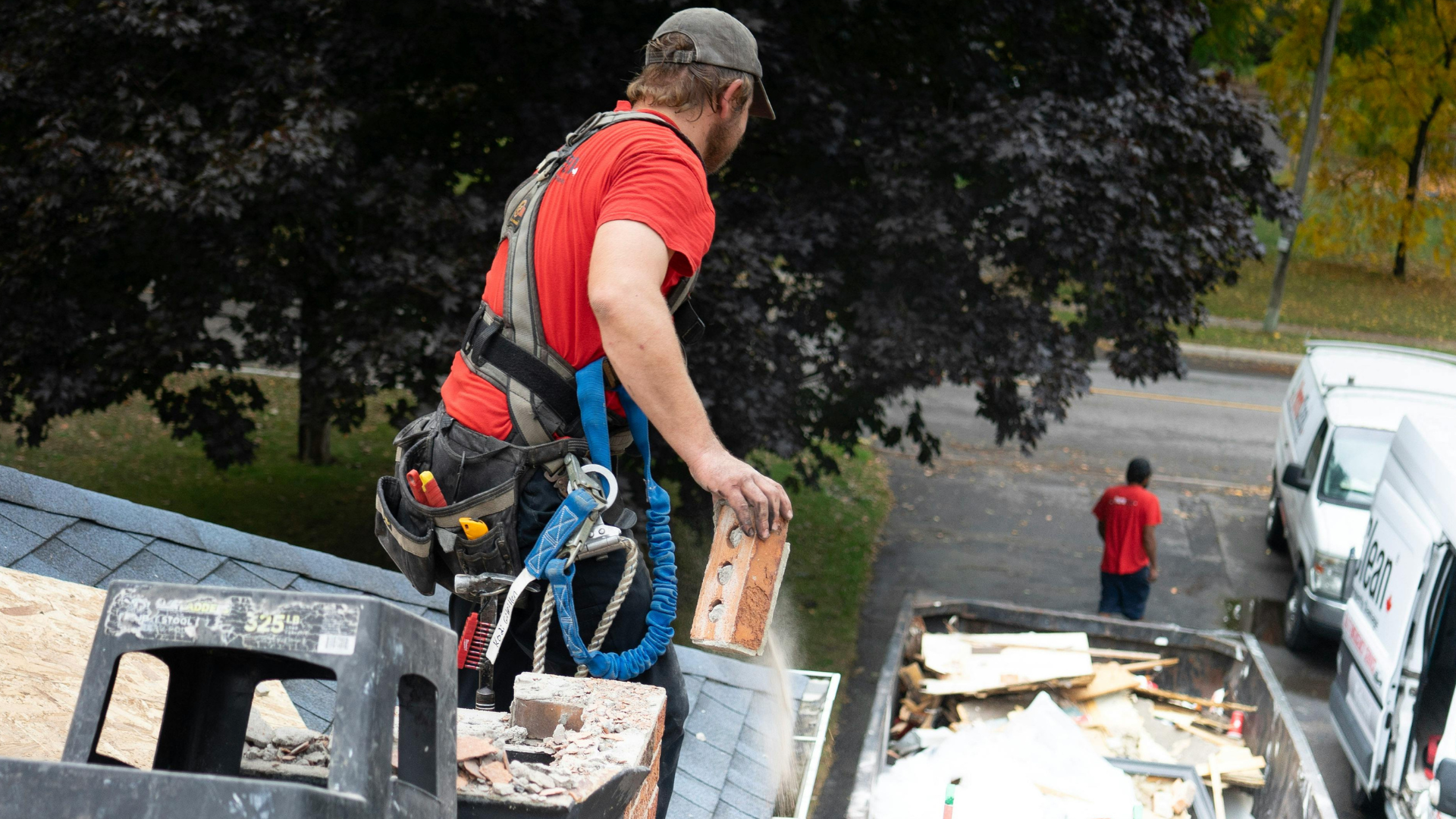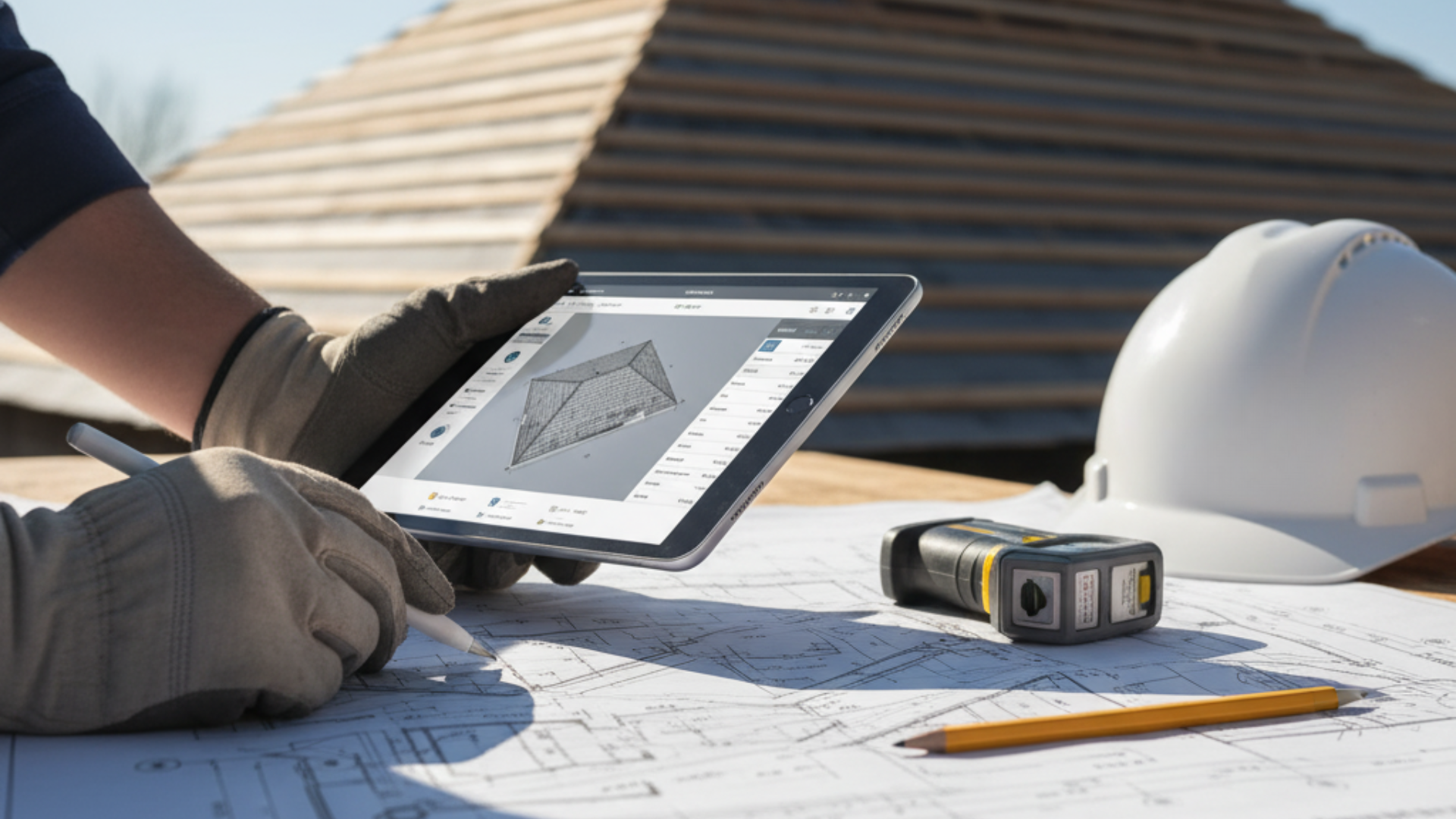June 26, 2025
Audio Overview: Listen & Learn
Phones buzzing, whiteboard grids smeared, crews stuck in traffic, customers wondering "where my crew is?" That’s a typical Monday for many roofing contractors.
A single mistyped date or missed phone call can snowball into extra material orders, wasted drive time, and unhappy clients.
Modern roofing management software flips that script with drag-and-drop calendars, automated reminders, and a single dashboard that your office staff and field team can access on any mobile device.
In this guide, you’ll see precisely how smart roofing software slashes delays, helps roofing companies finish more jobs, and gives owners the breathing room to grow their entire business, without looking at spreadsheets ever again.
The Real Cost of Poor Scheduling in the Roofing Industry
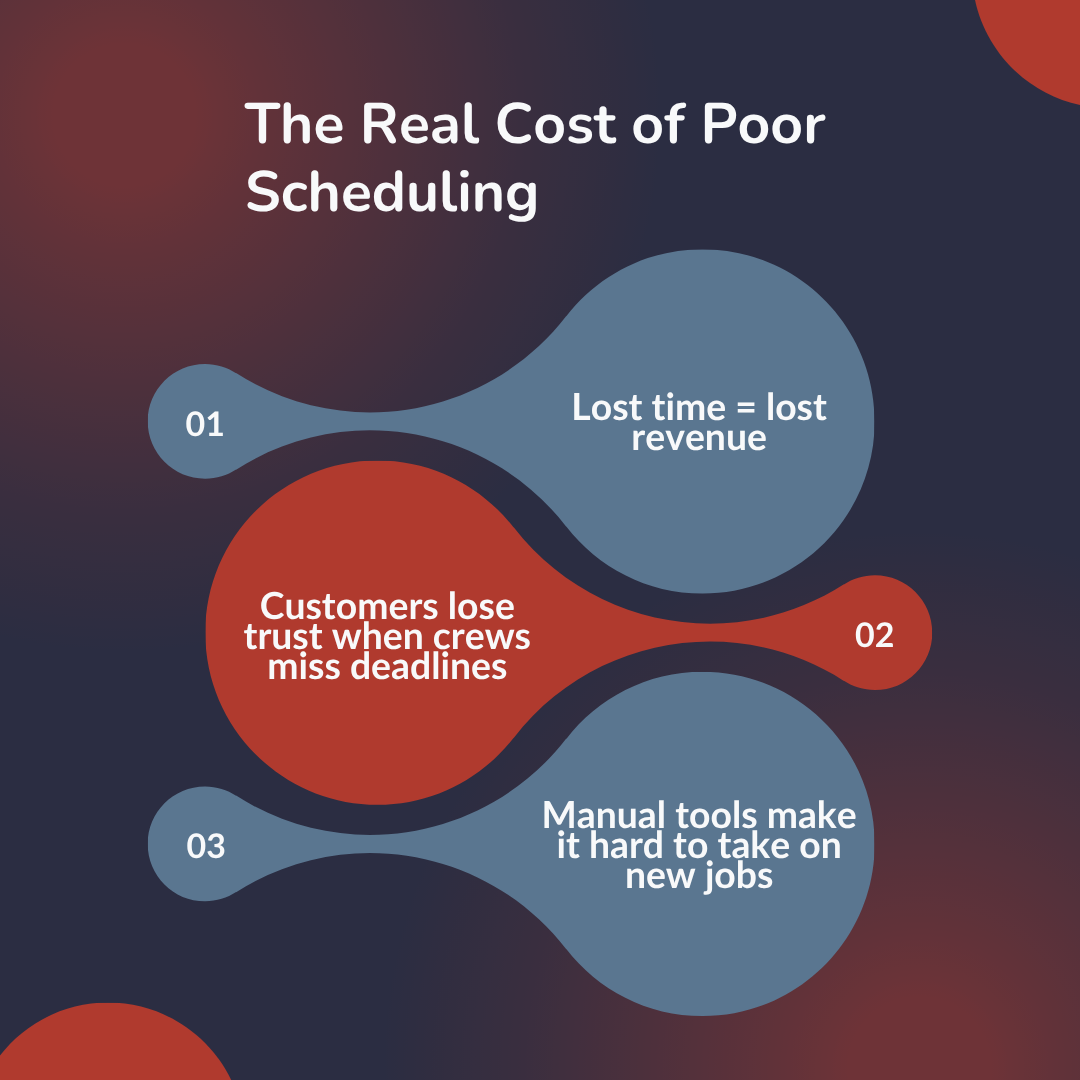
A quick look at why “just making do” with manual calendars drains profit faster than a leaking roof.
1. Time Lost = Revenue Lost.
Hours spent waiting for materials or idling at a job site are hours you aren’t billing. This unproductive downtime gradually eats into your profitability.
2. Issues with Customer Relationship Management
When install dates slip, homeowners flood the office with “Where’s my crew?” calls, eroding trust and jeopardizing referrals. Poor scheduling = Poor CRM.
3. Missed Roofing Projects
Constant reshuffling forces you to decline new estimates you could have landed. Competitors with streamlined schedules scoop up those jobs.
Key Takeaways
- Manual scheduling leads to delays, miscommunication, and lost revenue.
- Roofing management software streamlines crew coordination and job visibility.
- Templates, automation, and real-time updates speed up scheduling.
- Accurate measurements and proposals reduce waste and increase the likelihood of closing more deals.
- Data insights help roofing businesses grow with better planning and execution.
What the Best Roofing Software Consists Of
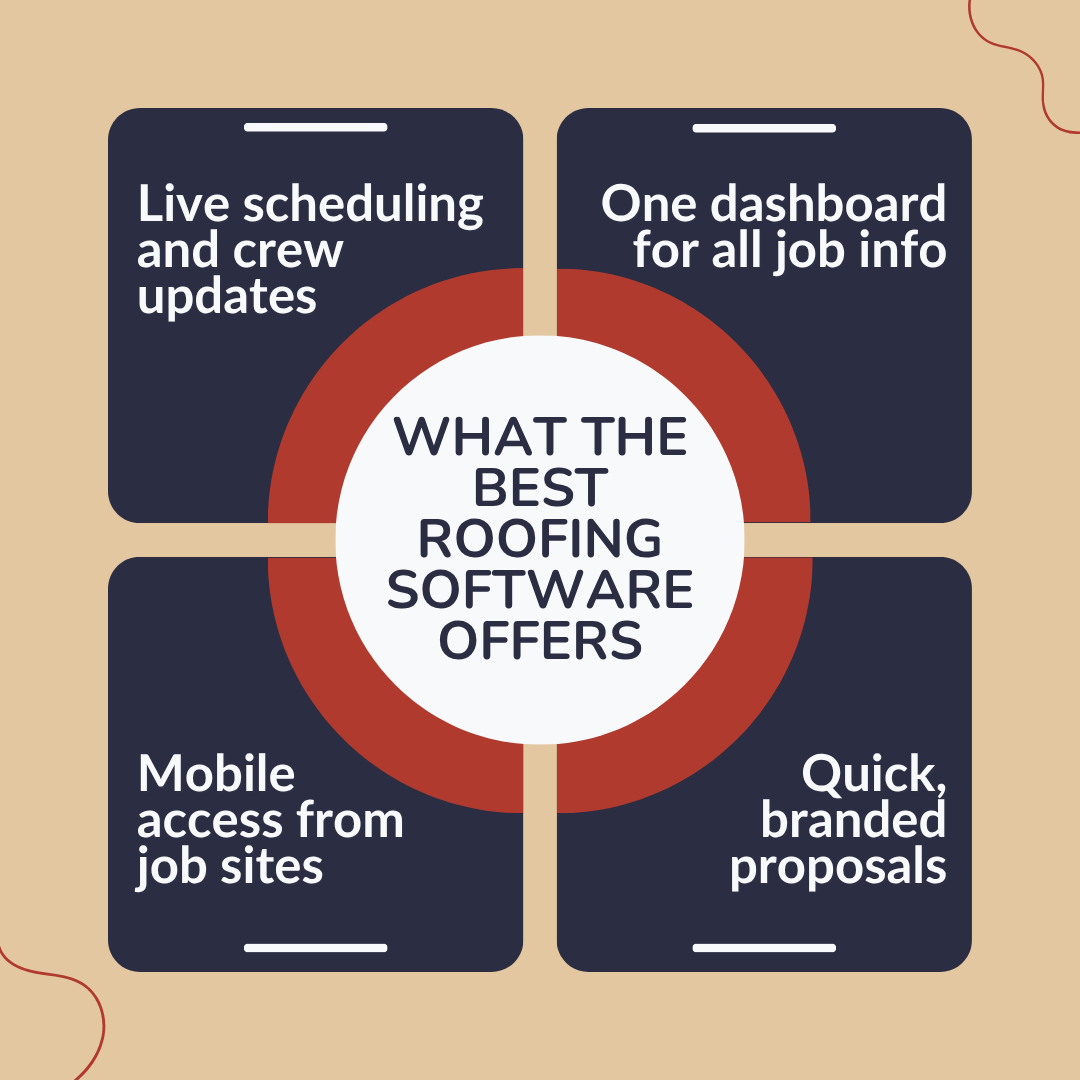
Here’s the feature checklist that separates a decent tool from a true game-changer.
1. Real-Time Scheduling and Updates
Move a job block, and every crew member sees the change instantly, no more guesswork or frantic calls.
2. Centralized Dashboard for Job Visibility
Owners, sales representatives, and production managers share a single screen for project status, material orders, and payment processing.
3. Mobile Access on the Job Site
Crews update job details, upload photos, and process payments from their phones, both online and offline.
A powerful roofing app makes it easy for them to stay synced, even when working in low-signal areas.
4. Professional Proposals
Generate polished, branded estimates in seconds, then convert them directly into scheduled jobs. With instant roof estimates, you can move from lead to scheduled job faster than ever.
You can even add customer financing options right inside the estimate to help close deals faster.
Professional estimates not only look great but also build trust during the sales process.
5. Fast and Accurate Measurements
Built-in measurement tools and affordable roof measurement reports eliminate manual calculations, thereby reducing costly overruns.
These tools help crews measure roofs precisely, avoiding costly rework or order errors.
5 Steps to Schedule Roofing Jobs Faster Using Software
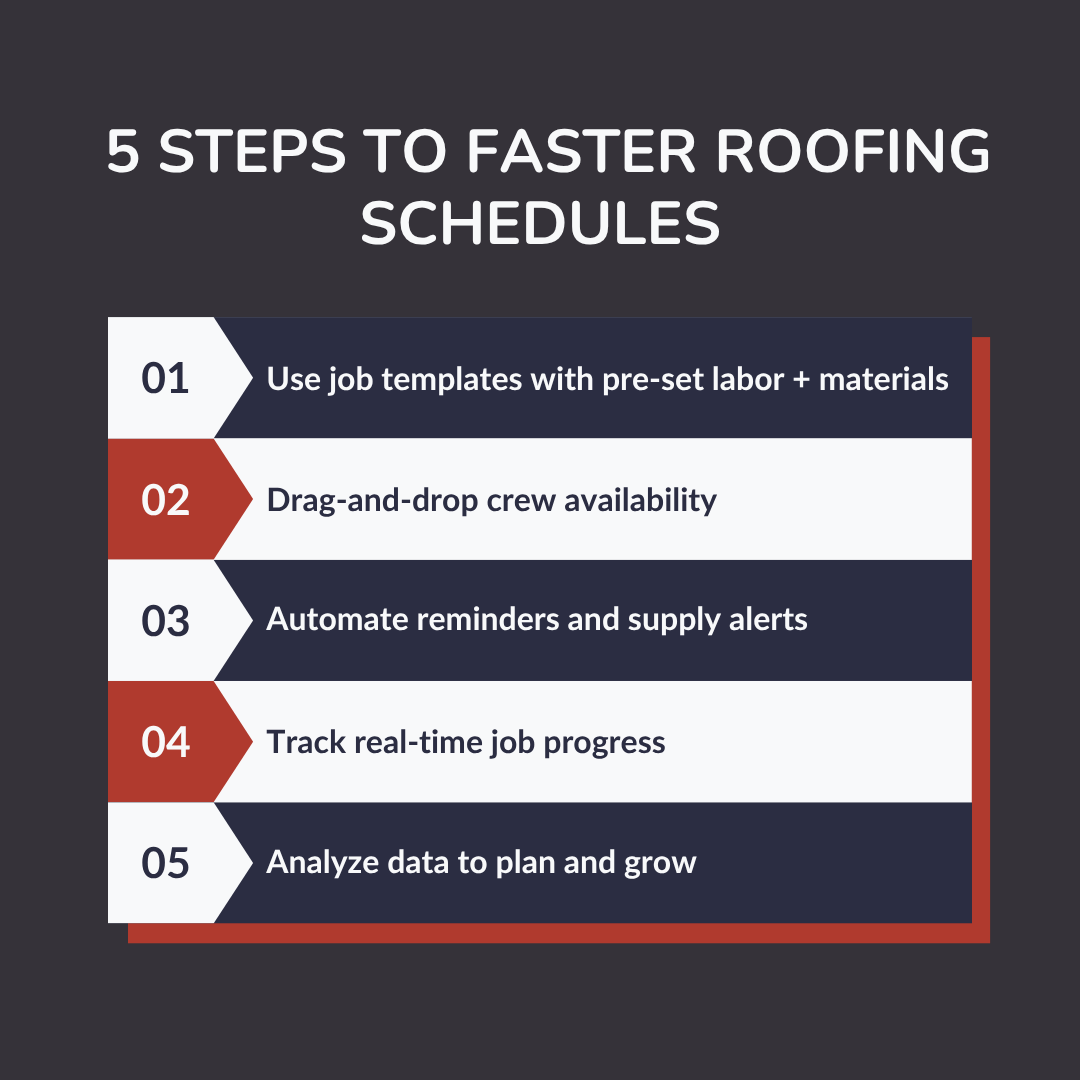
Follow this sequence once, and almost every future project will schedule itself.
Step 1 – Set Up Custom Job Templates
Start by analyzing your most common roof types, such as 30-square asphalt tear-offs and 50-square commercial TPO installations. Build templates with pre-loaded labor hours, and common roofing materials, such as underlayment, shingles, and fasteners, are pre-filled to save time.
Sales reps can clone a template, tweak a few details, and generate a proposal that automatically reserves labour slots and orders starter shingles in one click.
These templates help you create accurate estimates based on real-world labor hours, materials, and time slots.
Step 2 – Use Integrated Calendars for Team Availability
Colour-coded Gantt views reveal which crews are finishing early and which are being held up by weather delays.
Drag a job into an open slot and the software cross-checks licence requirements, certifies crew capabilities, and suggests the most fuel-efficient route based on the day’s project map.
Step 3 – Automate Reminders and Alerts
Set up SMS reminders 24 hours before arrival so clients can clear their driveways and prepare for pets.
Configure push alerts for crews when dump trailers arrive, and e-mails to suppliers when on-hand bundles dip below the threshold.
Automation prevents the micro-delays of forgotten nails and missing boots, which ripple into costly reschedules.
Step 4 – Track Progress in Real Time
Crews update % complete with a single tap. Production sees “tear-off finished” at 9:15 a.m. and dispatches the delivery truck for shingles instead of guessing at noon.
Everyone from sales to production can monitor project progress without waiting for field updates.
Job progress becomes instantly visible to office staff, helping them plan the next steps.
Step 5 – Analyse Scheduling Data for Future Planning
Dashboard analytics expose which project types overrun estimates and which lead sources consistently approve proposals within 48 hours.
Armed with performance data, owners can bid more aggressively, coach slow crews, and double-book rain-day make-up slots without risking overcommitment.
Utilize these insights to make more informed, data-driven decisions about job bids and resource allocation.
That’s the magic of using an all-in-one platform like Rooferbase, designed specifically for roofing teams.
The Difference between Manual Scheduling & Using Software

| Manual Scheduling | Using Roofing Software |
|---|---|
| Whiteboards & spreadsheets | Cloud-based, single platform |
| Relies on phone calls | Mobile app updates |
| No real-time visibility | Live dashboards & alerts |
| Hard to scale | Automates repetitive tasks |
| Frequent customer complaints | Higher satisfaction |
Check out: Roofing Software vs Manual Process: What’s Faster, Safer, and Cheaper?
What to look for in Roofing management software

If a platform can’t tick these boxes, keep shopping.
- Drag-and-Drop Calendar with Auto-Notifications – Schedule shifts and receive immediate alerts for crews and clients.
- Mobile App (Offline Mode) – Field updates sync even in low-signal areas.
- CRM Integration – One profile encompasses contact information, customer details, job history, and warranty reminders. Robust document management enables teams to upload, track, and access job files in a single location.
- Instant Estimating & Accurate Measurements – The right estimating tools help generate accurate roofing estimates, reducing bid errors and improving close rates.
- Inventory & Waste Tracking – Track nails, ridge caps, and dumpster usage in the box. Real-time inventory management prevents shortages and ensures materials are on hand when needed.
- Accounting software & Payment Processing – Trigger invoices and collect e-payments the moment the roof passes final inspection.
- Scalability for Residential and Commercial Roofing Projects – Handle everything from 15-square repairs to 300-square warehouses.
- Live Onboarding and Phone Support – Ensure crews over 50 aren’t left staring at a new screen with no idea what to tap.
Also read: Selecting the Best Roofing Software for 2025 — A Buyer’s Guide
Results You Can Expect After Using Roofing Software
Now, you’re probably asking: “Sure, but what does it really do for my business?”
Let’s break it down. Here are the real, measurable results you can expect after you start using modern roofing software, free of tech vocabulary or empty promises.
1. Increased Speed in the First 30 Days
You’ll feel the difference within the first month.
Tasks that previously took hours, such as creating quotes, scheduling jobs, or following up with clients, can now be completed in minutes.
- Create professional proposals in less than 10 minutes
- Access job details instantly from anywhere, even on-site
- Avoid searching through emails for estimates or addresses
Roofing software streamlines the busywork, enabling you to focus on what matters: closing deals and managing projects effectively.
2. Margin Expansion by Month 3
Fast forward to month three, and you will see even larger margins.
How? Roof management tools, such as Rooferbase, enable more precise tracking of labor, materials, and costs. This allows for smarter quoting rather than simply reducing prices.
- Avoid underbidding jobs that have built-in cost estimators.
- Keep track of real-time labor costs and adjust schedules as needed.
- Detect scope creep early to prevent it from impacting your profit.
With more accurate construction estimates and improved transparency of related costs, you're no longer leaving money on the table.
Minor improvements add up suddenly, you’re earning more per job without working extra. This is what roofing estimating software can do for you.
3. Revenue Lift in Year 1
By the end of the first year, the results clearly tell the story. Freed-up calendar blocks allow your roofing business to book additional roofing sales.
Beyond numbers, contractors cite better sleep, fewer Sunday-night “text the crew” headaches, and Google reviews littered with praise for “on-time” arrivals.
It’s the result of:
- Higher close rates (because proposals look sharp and arrive faster)
- More satisfied clients (because communication and project tracking are seamless)
- Automated workflows (because you’re not babysitting every task)
Most contractors experience a noticeable increase in annual revenue due to faster turnaround times, more intelligent pricing, and fewer costly errors.
This kind of consistency is what drives long-term customer satisfaction and repeat business. Upgrading your system gives you a significant edge in the competitive roofing game.
Rooferbase: Makes Your Roofing Jobs Faster Than Ever
Rooferbase is a dedicated roofing software that combines roofing CRM software, project management, estimating, and accounting into one cloud-based platform.
The roofing software includes task management, analytics, and proposal tools specifically designed for contractors.
Sales teams can create professional proposals with fast, accurate measurements, while production schedules jobs on a live calendar that crews can view in the field.
Owners can track KPIs, cash flow, and customer experience on a single dashboard.
Learn more about: Improving project precision using advanced roofing estimating software.
Summary
Manual calendars slow even the best contractors.
Roofing software eliminates guesswork by providing real-time scheduling, mobile access, and automated reminders, streamlining the roofing process.
You can template your jobs, sync integrated calendars, and study the data, which slashes delays, delights customers, and frees capacity for new roofing projects without
extra stress.
Visit Rooferbase Today!
Stop bleeding profit to messy scheduling.
Book a demo and discover how a single platform can streamline your roofing schedules, enhance margins, and keep every crew member on the same page.
FAQs
1. How does roofing scheduling software help small teams?
Even a three-person crew benefits from drag-and-drop calendars, automated reminders, and mobile updates, with no extra admin staff required.
2. Can I integrate Rooferbase with my current tools?
Yes. Rooferbase offers CRM, accounting, and measurement integrations.
3. What support does Rooferbase provide during setup?
Dedicated onboarding specialists, live chat, and phone support ensure you’re productive within days.


